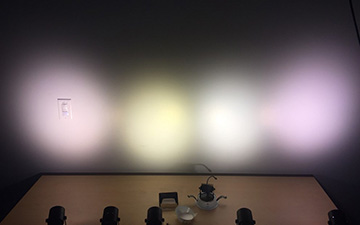
This photo shows a large difference in the tint of white light between different spots. Viewers of different ages disagree on which of these sources appears “most white” when compared to a reference source (here, the digital camera taking the photo selected the third spot for white balance). [Image: Soraa Inc., Fremont, Calif., USA]
Everyone wants luminaires to give off “white light.” But what, exactly, does that look like? Why does one person see a slight greenish cast to the white light, while another perceives a pinkish hue?
Researchers at a U.S. lighting development company have found a correlation between human age and the perception of white light (Opt. Express, doi:10.1364/OE.27.031553). And such age-related vision changes aren't embodied in traditional color-measurement models, developed in 1931 and 1976 before solid-state lighting became commonplace.
Tangled up in blue
Designers of LED lighting systems are concerned about human perception of white and short-wavelength light not just for the sake of aesthetics, but also for its impact on circadian rhythms. Sleep specialists say that exposure to significant levels of blue light at night may disrupt the brain’s normal bedtime cues. This detail poses a problem in lighting design, because most of the white-light LED sources that hit the market 20 years ago contain a blue pump that excites a yellow YAG phosphor.
To take blue light out of the equation, so to speak, Aurelien David of Soraa Inc., Fremont, Calif., USA, and his colleagues used four luminaires containing violet-pump LEDs that excite green and red phosphors. The spectral power distributions of these light sources contain few to none of the blue wavelengths thought to interfere with sleep.
The researchers designed the blue-free light sources to have roughly the same correlated color temperature—2700 to 2800 K—but varying in violet output, slightly altering their chromaticity.
Greener or pinker?
The team asked 64 participants to compare the four blue-free lights, one at a time, with three reference light sources that included both blue and violet radiation in the spectra. Most of the 64 viewers—all company employees without special training in color theory—ranged in age from 25 to 64, and roughly two-thirds were male.
Although most participants agreed on which of the blue-free lights appeared greener or pinker relative to each other, the researchers noted a systematic trend: the older participants perceived the lights to be greener than the younger participants. “Older participants generally have a lower sensitivity to short-wavelength radiation, causing them to perceive less of the violet peak needed for chromaticity blending and therefore to report greener tints,” the team reported.
The company—founded by University of California Santa Barbara professors, including 2014 Nobel Prize winner Shuji Nakamura—could use the research to improve the lighting spectra of future LED fixtures.
